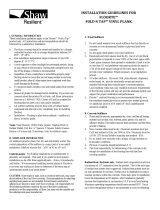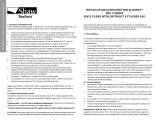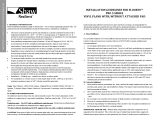Page is loading ...

I. GENERAL INFORMATION
These installation guidelines apply to the Floorte™ Fold n Tap™
product only. All instructions and recommendations should be
followed for a satisfactory installation.
The floor covering should be stored and installed in a climate
controlled location with an average temperature between 55° -
85°F - 13°-29°C.
Failure to follow these guidelines may result in an installation
failure. Floorte™ is an interior product and must be installed in
a temperature- controlled environment, maintained between 55
and 85 degrees F - 13°-29°C.
Avoid exposure to direct sunlight for prolonged periods, doing
so may result in discoloration. During peak sunlight hours, the
use of the drapes or blinds is recommended.
Regardless of new construction or remodeling projects, keep
flooring stored in rooms that are not being worked in and only
install product after all other trades have completed work that
could damage the flooring.
To minimize shade variation, mix and install planks from several
cartons.
Inspect all planks for damage before installing. If you have any
concerns about the product fit or finish, call Shaw Information
Services at 1-800-441-7429. Claims will not be accepted for
flooring that has been cut to size and/or installed.
All subfloor patching must be done with a Portland based
compound and allowed to dry completely prior to installing
flooring.
Installation – Floating or glue down methods - installed on,
above, or below grade.
Tools:
Tape Measure, Utility Knife, Jigsaw, Tapping Block or
Rubber Mallet, Pull Bar, ¼" Spacers, T-Square, Safety Glasses,
Broom or Vacuum and, if necessary, tools for subfloor repair.
II. SUBFLOOR INFORMATION
All subfloors must be clean, flat, dry and structurally sound. The
correct preparation of the subfloor is a major part of a successful
installation. Subfloor must be flat – 3/16" in 10' or 1/8" in 6'.
Underlayments
– If floating installation – Approved underlayments -
Bravo and Selitac. Do not use non recommended underlayments.
CAUTION:
Some types of nails, such as common steel nails, may cause
discoloration of the vinyl floor covering. Recommendations for attaching
underlayment panels are not included. Solvent based construction
adhesives are known to stain vinyl floor coverings. All responsibility for
discoloration problems caused by the use of the above mentioned
products is not the responsibility of Shaw, but rests with the installer and
the underlayment panel manufacture
A. Wood Subfloors
1.
Do not install material over wood subfloors that lay directly on
concrete or over dimensional lumber or plywood used over
concrete.
2.
Do not apply sheet plastic over wood subfloors.
3.
Basements and crawl spaces must be dry. Use of a 6 mil black
polyethylene is required to cover 100% of the crawl space earth.
Crawl space clearance from ground to underside of joist is to be
no less than 18” and perimeter vent spacing should be equal to
1.5% of the total square footage of the crawl space area to
provide cross ventilation. Where necessary, local regulations
prevail.
4.
All other subfloors - Plywood, OSB, particleboard, chipboard,
wafer board, etc. must be structurally sound and must be
installed following their manufacturer’s recommendations.
Local building codes may only establish minimum requirements
of the flooring system and may not provide adequate rigidity and
support for proper installation and performance.
5.
Floorte™ resilient flooring is not recommended directly over
fire-retardant treated plywood or preservative treated plywood.
An additional layer of APA rated 1/4" thick underlayment
should be installed.
B. Concrete Subfloors
1.
Floors shall be smooth, permanently dry, clean, and free all foreign
material such as dust, wax, solvents, paint, grease, oils, and old
adhesive residue. The surface must be hard and dense, and free from
powder or flaking.
2.
New concrete slabs must be dry. Maximum moisture level per
CaCl test method is 8 lbs. per 1000 in 24 hr. Maximum level for
ASTM 2170 In-situ Relative humidity test method - 85%.
3.
Do no install over concrete with a history of high moisture or
hydrostatic conditions.
4.
Ph level of concrete should be between 5- 9
5.
The final responsibility for determining if the concrete is dry
enough for installation of the flooring lies with the floor
covering installer.
Radiant Heat: Hydronic only -
Radiant heat components must have
a minimum of 1/2" separation from the product. This is the only type
of radiant heat system that is approved. Radiant heat system must be
on and operational for at least 2 weeks prior to installation to reduce
residual moisture within the concrete. Three days prior to installation
lower the temperature to 65 degrees, after installation gradually
increase the temperature in increments of 5° F to avoid overheating.
Maximum operating temperature should never exceed 85°F. Use of
an in-floor temperature sensor is recommended to avoid overheating.
INSTALLATIONGUIDELINESFOR
FLOORTE™
FOLDNTAP™VINYLPLANK
For reference purposes only if printed or downloaded.

!
WARNING! DO NOT SAND, DRY SWEEP, DRY SCRAPE,
DRILL, SAW, BEADBLAST OR MECHANICALLY CHIP OR
PULVERIZE EXISTING RESILIENT FLOORING, BACKING,
LINING FELT, ASPHALTIC “CUTBACK” ADHESIVES OR
OTHER ADHESIVES.
These products may contain either asbestos fibers and/or crystalline
silica. Avoid creating dust. Inhalation of such dust is a cancer and
respiratory tract hazard. Smoking by individuals exposed to asbestos
fibers greatly increases the risk of serious bodily harm. Unless
positively certain that the product is a non-asbestos-containing
material, you must presume it contains asbestos. Regulations may
require that the material be tested to determine asbestos content and
may govern the removal and disposal of material. See current edition
of the Resilient Floor Covering Institute (RFCI) publication
Recommended Work Practices for Removal of Resilient Floor
Coverings for detailed information and instructions on removing all
resilient covering structures. For current information go to
www.rfci.com
C. Existing Floor Coverings
Floorte™ flooring can be installed over most existing hard–
surface floor coverings, provided that the existing floor surface
is clean, flat dry and structurally sound.
Existing sheet vinyl floors should not be heavily cushioned and
not exceed more than one layer in thickness. Soft underlayment
and soft substrates will diminish the products inherent strength in
resisting indentations.
Installation is NOT allowed over any type of carpet.
Never use solvents or citrus adhesive removers to remove old
adhesive residue. Solvent residue left in and on the subfloor may
affect the new floor covering.
III. INSTALLATION
Floating Installation:
Floorte™ plank flooring is designed to be installed utilizing the
floating method. Never secure the planks to the subfloor. Do not
install cabinets or fixed objects on top of the flooring. Proper
expansion space (1/4”) is required. Undercut all doorjambs. Do not
fasten wall moldings and or transition strips to the planks.
Glue Down Installation:
On, above and below grade. Floorte™ is
approved for glue down installation over approved wood and
concrete substrates. Recommended adhesive- Shaw 200 or
Kwikflash adhesive. Use a 1/16”x1/16”x 1/16” sq. notch trowel. If
this product has an attached pad, T180 or an industry equivalent
adhesive is required. Follow adhesive label instructions. Maintain ¼”
perimeter expansion space. Moisture testing and limits for glue down
- maximum
ASTM F-1869 - 5 lbs. or less per CaCl test method
ASTM F-2170 – 85% RH or less
The PH level should be between 5-9
1. Before you start with the installation, it is important to determine
the layout of the flooring. Proper planning and layout will prevent
having narrow plank widths at wall junctures or very short length
pieces at the end of rows.
2. As with all plank products, install the planks parallel to the
longest exterior wall.
3. Determine if the starter row will need to be cut. If the first row
of planks does not need to be trimmed in width, it will be
necessary to cut off the unsupported tongue so that a clean, solid
edge shows towards the wall.
4. Installation of the product must start from the left side of the
room, working to the right when working in front of the planks
or facing the starting wall. Use spacers along the walls to
maintain proper expansion space (1/4”) and align the first plank.
5. Install the second plank in the row by aligning and dropping the end
tongue over the end groove of the first plank. Apply light pressure to
join the two planks together.
6. If needed use a rubber mallet to fully engage the short side of the
plank by lightly tapping the plank to engage and sit flush with the
adjacent plank. Maintain an expansion gap of approximately 1/4"
from the wall. Repeat this process to complete the first row.
7. Start the second row by cutting a plank to the desired length. Keep
in mind that the plank must not be shorter than 6" (15cm) to achieve
the best appearance.
8. Install the first plank in the second row by inserting the long side
tongue into the groove of the plank in the first row. This is best
done with a low angle of the plank. Maintain light pressure into
the side seam as you rotate the plank to the subfloor. Repeat the
process with additional planks to complete each row. Very little
force is required to seat the tongue into the groove. You should
feel the tongue lock into the groove.
9. It is critical to keep the first two rows straight and square, as
they are the “foundation” for the rest of the installation. Check
for squareness and straightness often.
10. Continue installing planks and make sure to achieve a random
appearance with end pieces of minimum 6" - 15cm. Check that
all planks are fully engaged; if a slight gapping is found, the gap
can be tapped together by using a tapping block and a scrap of
flooring to cover the tapping block in order to avoid damages on
the planks.
11. When fitting under door casings, if necessary, a flat pull bar may
be used to assist in locking the planks.
12. When fitting around obstacles or into irregular spaces, planks
can be cut easily and cleanly using a utility knife with a sharp
blade. It is often beneficial to make a cardboard template of the
area and transfer this pattern to the plank.
13. Protect all exposed edges of the flooring by installing wall
molding and/or transition strips. Make sure that no plank will be
secured in any way to the sub floor.
14. For wet areas such as bathrooms caulk the perimeter of the floor
with a silicone caulk.
15. Protect the finished flooring from exposure to direct sunlight.
© 051515 Shaw Industries Group, Inc., a Berkshire Hathaway
Company
For reference purposes only if printed or downloaded.
/



